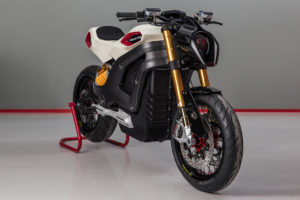 It’s obvious that many motorcycles are meant for speed over comfort—not to mention the adrenaline flow of riding on two wheels out in the open and the fresh air, as opposed to being in an automotive ‘cage.’ There are many different ways to make a bike these days, and 3D printing is becoming more and more popular for progressive manufacturers and resourceful enthusiasts.
It’s obvious that many motorcycles are meant for speed over comfort—not to mention the adrenaline flow of riding on two wheels out in the open and the fresh air, as opposed to being in an automotive ‘cage.’ There are many different ways to make a bike these days, and 3D printing is becoming more and more popular for progressive manufacturers and resourceful enthusiasts.
We’ve reported on some very interesting and innovative designs in the past few years, to say the least. You may have followed the story of the custom and record breaking electric motorcycle designed by Dr. Eva Håkansson, as she relied on 3D printed parts from a LulzBot TAZ 3D printer. Or maybe you were entranced by the 3D printed Dagger – a streetfighter by Divergent 3D.
 Now comes the Italian Volt Lacama, a bike that’s able to change its shape and body thanks to the power of 3D printing. It also offers an electric motor over the typical combustion engine, with Italian Volt referring to their new creation as ‘the first custom electric motorcycle.’ Lacama is derived from the Italian word la camaleonte, for chameleon—a name that is both exotic and appropriate.
Now comes the Italian Volt Lacama, a bike that’s able to change its shape and body thanks to the power of 3D printing. It also offers an electric motor over the typical combustion engine, with Italian Volt referring to their new creation as ‘the first custom electric motorcycle.’ Lacama is derived from the Italian word la camaleonte, for chameleon—a name that is both exotic and appropriate.
The Lacama shows the benefits of 3D printing at their finest—as well as some of the most exciting. Not only does the 3D printer allow for incredible latitude and self-sustainability in design and manufacturing, but also in the ability to customize parts for motorcyclists—and lightweight ones that add to the speed factor. For those who are fond of creating their own bikes, they may not only be interested in the Lacama but also the future of DIY motorcycles with 3D printing.
“Each Italian Volt is unique. Our customers own a limited edition motorbike. An edition of one piece only. With his design elements configured, the vehicle is completely modifiable to design a unique motorbike,” states the Italian Volt team on their website. “Italian Volt is conceived to be the personal creation of its own rider, working as a sort of design canvas for a tailor-made riding high class experience.”
The first Lacama prototype took 6,000 hours to make, with pre-orders expected to start in September. It goes from 0 to 62 in 4.6 seconds, with a 112-mile range in eco-mode, and an 80 percent charge in 40 minutes. The price should be around €35,000.
Those purchasing these futuristic motorcycles will also be able to look forward to a mobile app (available on both iOS and Android) for keeping an eye on how the Lacama is charging and its location, as well as a screen that allows you to check out the range of ride profiles.
 Founded in 2016, Italian Volt is on a mission to expand the realm of the motorcycle, combining high end with high performance. Find out more about this new innovative company here. Share your thoughts in the Lacama forum at 3DPB.com.
Founded in 2016, Italian Volt is on a mission to expand the realm of the motorcycle, combining high end with high performance. Find out more about this new innovative company here. Share your thoughts in the Lacama forum at 3DPB.com.
Subscribe to Our Email Newsletter
Stay up-to-date on all the latest news from the 3D printing industry and receive information and offers from third party vendors.
Print Services
Upload your 3D Models and get them printed quickly and efficiently.
You May Also Like
Johns Hopkins University Researchers Develop HyFAM Technology
Two scientists from Johns Hopkins University, Nathan C. Brown and Jochen Mueller, have developed a hybrid manufacturing technology they call HyFam, or Hybrid Formative Additive Manufacturing. Their work on this technology...
3D Printing G-Code Gets an Upgrade: T-Code
Good old G-Code still manages many 3D printers, great and small. Just like the STL, it’s a standard that enables collaboration while also holding the additive manufacturing (AM) industry back....
AM Rewind: The Biggest News and Trends of 2024
After a sluggish 2023, driven by persistent inflation and geopolitical tensions, 2024 has seen some recovery. Economic growth climbed from about 2.8 percent in 2023 to a modest 3.2 percent...
Metal Wire 3D Printer OEM ValCUN Announces Plans for 2025 Expansion
ValCUN, a Belgian original equipment manufacturer (OEM) of wire-based metal additive manufacturing (AM) hardware, has announced that the company has entered the next phase of its growth trajectory, making key...



































